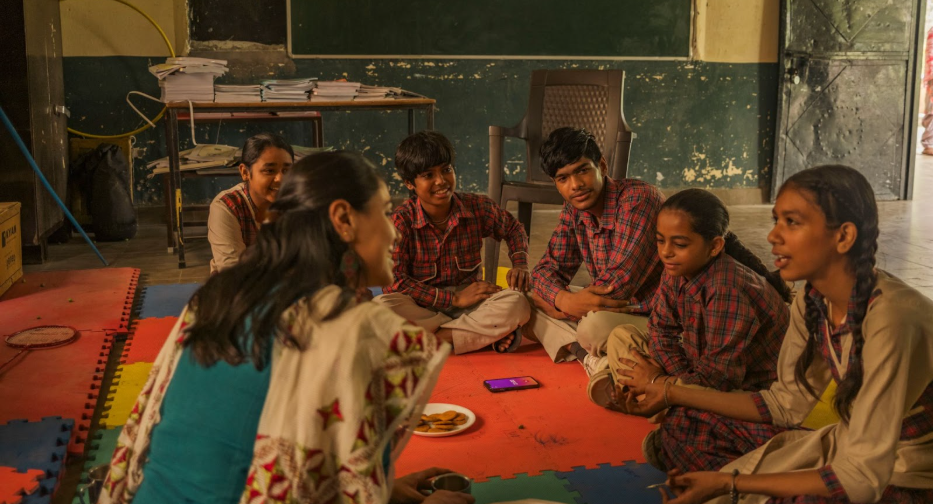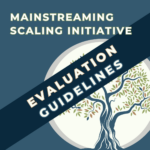
Consider this: An Indian child spends eight years in school—eight years that have the potential to either reinforce outdated norms or challenge them. For a country like India, ranked 129th on the World Economic Forum’s 2024 Gender Gap Index, these formative years are critical. So, could the solution to gender inequality begin in the classroom?
Adolescent years are pivotal, as they represent a formative period when children are developing their values and perspectives. A randomized evaluation led by J-PAL-affiliated researchers has demonstrated that it is possible to instill progressive gender norms through an engaging and interactive gender sensitization curriculum in classrooms. Building on these results, the program is now being expanded to other states,
In India, where deeply entrenched conservative gender norms shape the lives of women, schools are emerging as the likely arenas where progressive gender attitudes can be nurtured. The conditioning starts early. Women are typically shown in caregiving roles, while men dominate leadership and technical fields. Examples of success in STEM and history are overwhelmingly male, marginalizing women, and limiting their representation in science, history, and leadership roles (Crawfurd, Saintis-Miller, and Todd, 2024). Yet, there are glimmers of hope. States such as Kerala, Maharashtra, and Karnataka are updating their textbooks to reflect more inclusive, gender-equitable content.
In Punjab, however, the shift goes beyond updating textbooks; it’s about reshaping mindsets. The Chanan Rishman Program, a gender sensitization curriculum launched by the Department of School Education, is demonstrating how education systems can drive social change. Based on Breakthrough Trust’s Taaron Ki Toli (Gang of Stars) program, the curriculum has shown promising results in a randomized evaluation conducted by J-PAL affiliated researchers, led by Seema Jayachandran (Princeton University) and her co-authors in Haryana. The program showed that 16% of students adopted more progressive views on gender equality after completing the program. Notably, boys began taking on more household chores and advocating for the women in their families.
Building on these insights, the program was launched in March 2021 and is significantly changing the state’s educational landscape. Targeting grades 6-8, the curriculum focuses on adolescents during their most formative years. It now reaches 800,000 students annually across 6,250 government schools in Punjab.
One of the most interesting aspects of the program is that teachers have become champions of change, while students are starting to question the prevailing social norms.
Now in its third year, the Chanan Rishman Program has transitioned from theory to practice, driving real-world change. Through interviews with teachers and students, process monitoring, and pre-post studies, J-PAL South Asia is uncovering compelling stories that highlight the human impact of this initiative. Breakthrough has been instrumental in this journey, playing a key role in designing the program’s curriculum and providing comprehensive training to empower teachers as agents of change.
J-PAL South Asia has been working closely with teachers, students, and communities involved in Chanan Rishman. We have collected stories that reveal how a thoughtfully designed curriculum can transform not just classrooms but entire societies. It’s a story of hope, progress, and the power of education to challenge the status quo and ignite change.
How did we get here: From Curriculum Design to Real-World Change
At its core, the Chanan Rishman curriculum is about sparking conversations and discussions.
What sets the program apart is its focus on sustainability. In the randomized evaluation in Haryana, Breakthrough facilitators conducted gender-sensitization sessions after school. While this approach was effective, it highlighted opportunities for enhancing the scalability of a government delivery model. Punjab integrated the curriculum into existing Social Studies and English lessons for grades 6-8, ensuring its smooth integration into regular classroom activities.
Initially delivered through supplementary textbooks to introduce the content, the curriculum was later, fully integrated into standard textbooks, streamlining its delivery.
The program’s success hinged on a cascading model of training. Master trainers, trained intensively by Breakthrough Trust, ensured that concepts were consistently passed on to Social Studies and English teachers through the regular District Institute of Education and Training (DIET) structure. This structure ensured that the program could scale without compromising its quality.
Process Monitoring results reveal that teachers who had undergone training expressed confidence in their ability to facilitate discussions, with sessions including interactive role plays and group discussions. In classrooms where teachers did not receive regular refresher training, activities which were meant to be interactive were reduced to passive reading with minimal engagement. This highlights the importance of regular, ongoing training to empower teachers with the necessary skills for delivering the curriculum effectively.
J-PAL South Asia’s institutional partnership with the Punjab government was another indispensable factor. Early buy-in from the government was crucial, as it allowed the program to be institutionalized within the state’s educational system. From logistical support, like ensuring that training materials and textbooks were printed and distributed at scale, to facilitating regular refresher training for teachers, the government’s involvement ensured that the program had the necessary infrastructure to succeed.
J-PAL South Asia’s and Breakthrough’s continuous monitoring and feedback loop also played a key role in maintaining the quality of implementation and adjusting the program to meet local needs.
The curriculum’s design ignites discussions about gender roles, violence against women, and inequities, extending these lessons beyond the classroom into homes. Notably, the transformative impact is felt not only by the students but also by the teachers who facilitate these discussions.
For Chhavi, an English teacher in Roopnagar, this change began at home:
 “I was so happy with the teacher training and curriculum that I passed on the teacher guide to my mother who runs a creche. I’ve been seeing small differences in my mother’s outlook towards what girls can do since then.”
“I was so happy with the teacher training and curriculum that I passed on the teacher guide to my mother who runs a creche. I’ve been seeing small differences in my mother’s outlook towards what girls can do since then.”
Ramandeep Kaur, a Social Studies teacher, found the curriculum influenced her life beyond the classroom:
 “After the curriculum, I started teaching my son household chores like cooking and cleaning, explaining that it’s not just a woman’s responsibility. I wish I’d had this curriculum when I was younger—it would have encouraged me to be more ambitious.”
“After the curriculum, I started teaching my son household chores like cooking and cleaning, explaining that it’s not just a woman’s responsibility. I wish I’d had this curriculum when I was younger—it would have encouraged me to be more ambitious.”
Ramandeep’s realization is echoed in her classroom. Students, inspired by these lessons, are beginning to reflect on and address inequalities within their own homes. A Grade 8 student from Chatamli, reflected on how her family had changed after learning about gender roles in class:
“When my little brother gets older, I want to make sure he understands that household chores aren’t just something for girls to do. It’s important for everyone, boys and girls, to help out around the house. I’ll show him that sharing responsibilities is the right thing to do.”
Embedding Chanan Rishman into Social Studies and English curricula has been critical to ensure its sustainability. By aligning with existing education frameworks, the program became a permanent fixture in the classroom rather than a one-off initiative.
These efforts weren’t just about changing what students learned but also how they learned. The curriculum’s activity-based approach made discussions on gender more relatable. Teachers and students have begun to see gender equity not as an abstract concept but as something that could be acted upon in everyday life.
Harman, a Grade 7 student, recalls how the curriculum changed his perspective on helping with house chores.
 “I have started to help my mom around the house. I do things like sweeping and cleaning because it’s important to share responsibilities and help out.”
“I have started to help my mom around the house. I do things like sweeping and cleaning because it’s important to share responsibilities and help out.”
Harman’s realization is an important one: gender equality isn’t just something we talk about; it’s something we live with every day.
For the program to truly succeed, its lessons needed to go beyond the classroom. Assignments encouraged students to take these discussions home, sparking conversations about gender roles within their families. Students became catalysts for change, challenging traditional notions of housework, education, and ambition.
For students like Khushneh, the curriculum has been a window into a world of possibilities. A Grade 8 student, she dreams of becoming the first female police officer in her family—a goal she wouldn’t have voiced before.
 “When I grow older, I want to be a police officer. My cousin is a police officer, and no girl has ever become one in my family. I want to be the first girl in my family to achieve that and make a difference.”
“When I grow older, I want to be a police officer. My cousin is a police officer, and no girl has ever become one in my family. I want to be the first girl in my family to achieve that and make a difference.”
In the Chanan Rishman classrooms, changes are not just theoretical—they are profoundly practical. Sukhjinder Singh, a teacher in Fatehgarh Sahib, shares a breakthrough moment:
 “In one session discussing gendered roles in families–Girls questioned why homemaking was seen as a woman’s role, and boys returned the next day, proudly sharing how they helped their mothers in the kitchen.”
“In one session discussing gendered roles in families–Girls questioned why homemaking was seen as a woman’s role, and boys returned the next day, proudly sharing how they helped their mothers in the kitchen.”
Another grade 7 male student, reflected on a question posed in class: “Should your gender dictate your ambition?” His response was simple but profound:
“At my school, boys and girls are treated equally. So if a girl is passionate and knowledgeable about any field, she can pursue it without any issues.”
The program’s greatest strength lies in its ability to extend lessons beyond the classroom. Engaging families with the curriculum creates opportunities to influence a broader audience, including adults—laying the foundation for lasting change at both school and home. Process monitoring surveys conducted across 130 schools highlight the program’s significant impact, with students actively participating in meaningful discussions on topics such as gender equality and discrimination.
A robust partnership with the Punjab Government has been instrumental in bridging gaps in teacher training and curriculum resource distribution. Their unwavering commitment is evident in initiatives like appointing District and Block Resource Coordinators to oversee implementation and ensure that educators receive timely, high-quality support. These coordinators play a vital role in delivering formal refresher training and facilitating the seamless distribution of updated resources to schools, effectively addressing challenges faced by educators who have yet to receive such training.
This collaboration reflects the Punjab Government’s dedication to fostering a more equitable education system and driving transformative social change. Their efforts underscore the program’s potential to create a ripple effect, embedding principles of gender equity deeply into the fabric of education and society.
Lessons from Punjab and the Road Ahead
The Chanan Rishman Program’s journey from concept to scale underscores how a strong collaboration between governments, civil society organizations, and educators can drive systemic change.
However, this scale was not achieved without obstacles. One of the most pressing concerns is ensuring the program’s continued resilience amid frequent revisions of curriculum frameworks. It’s crucial to safeguard the integration of gender sensitization content into the state’s formal curriculum. Ensuring that future curriculum revisions retain the focus on gender equity is vital to preventing the dilution of its impact.
Moreover, scaling the program’s impact beyond the classroom requires engaging the broader ecosystem surrounding students, particularly parents and school management committees. Gender norms are deeply embedded within households and communities, and for lasting change to occur, attitudes must evolve not only within the classroom but also at home. Some initiatives have sought to involve parents in gender sensitization efforts, aiming to reinforce the messages students receive in school. While there is limited rigorous evidence on the impact of such approaches, engaging parents in discussions on gender norms could help create a more supportive environment for change. Parents are the first line of influence on children’s perceptions of gender roles, and their involvement may contribute to ensuring that lessons learned in school are reinforced at home. However, further research is needed to better understand the impact of engaging parents in this process.
The importance of ongoing monitoring also cannot be overstated. As the program scales, the government must take ownership of process monitoring, ensuring that teacher training is continuously reinforced and that the curriculum evolves based on real-time feedback. Without these systems in place, the program risks losing its effectiveness as it grows.
The Chanan Rishman model has demonstrated its scalability, but its long-term success depends on expanding government adoption beyond Punjab. Effective scaling requires adapting the curriculum to regional contexts and leveraging innovative delivery methods. A key example of this is the program’s expansion to Odisha, where J-PAL South Asia and Breakthrough have worked to contextualize the curriculum for students in grades 6–10, addressing region-specific demographic and social dynamics.
The program’s success has been driven by a strong partnership between Breakthrough Trust, the state education department, and local educational institutions. This collaborative model is essential for replication in other regions. To enable sustainable scaling, J-PAL South Asia and Breakthrough are working closely with government stakeholders to embed the program within state education systems, integrate it into official curricula, and establish the necessary infrastructure for teacher training, material distribution, and ongoing monitoring. Ultimately, the program’s success serves as a blueprint for other Indian states, demonstrating that gender equity is not just a theoretical ideal but an achievable reality when education systems commit to change.
Reshaping gender narratives is a long-term endeavor, and the Chanan Rishman Program proves that transformative progress can stem from small, intentional steps.
Embedding gender equity into regular classes and equipping teachers with continuous training are creating ripples of change, as evidenced by students critically questioning gender roles and confidently embracing new possibilities. Through process monitoring, it can be seen how inclusive teaching practices inspire boys to challenge traditional norms and empower girls to pursue their ambitions unapologetically.
The stories emerging from Punjab’s schools remind us that real change starts with a shift in perspective—and these students are paving the way for a future defined not by gendered boundaries but by equality, opportunity, and shared potential.



